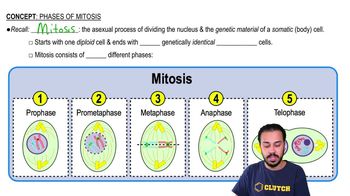Here are the essential concepts you must grasp in order to answer the question correctly.
Mitosis
Mitosis is the process of cell division that results in two genetically identical daughter cells. It consists of several stages: prophase, metaphase, anaphase, and telophase. During metaphase, chromosomes align at the cell's equatorial plane, ensuring that each daughter cell will receive an identical set of chromosomes.
Recommended video:
Chromatids
Chromatids are the two identical halves of a replicated chromosome, joined together at a region called the centromere. During metaphase, each chromosome consists of two sister chromatids, which are crucial for accurate segregation during cell division. This ensures that each daughter cell receives the correct number of chromosomes.
Recommended video:
Cytokinesis
Cytokinesis is the final step of cell division, occurring after mitosis, where the cytoplasm of a parental cell is divided into two daughter cells. It typically begins during telophase and involves the formation of a cleavage furrow in animal cells or a cell plate in plant cells. It is essential for completing the cell division process and ensuring that each daughter cell is a separate entity.
Recommended video:
 Verified step by step guidance
Verified step by step guidance



 3:21m
3:21m